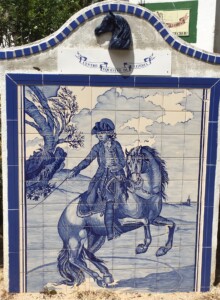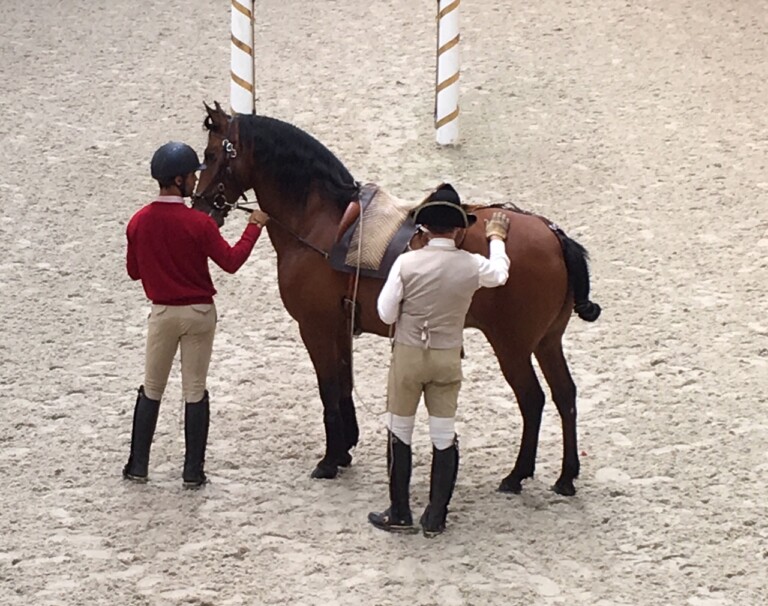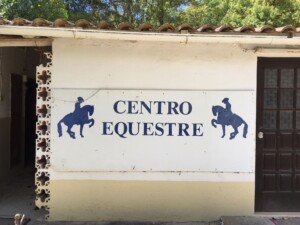Jane Camens put her best riding foot forward and recently spent a week in Portugal at the Valença Equestrian Academy learning the first steps of classical dressage.
To ride at the Valença Equestrian Academy in Portugal is a privilege that this novice rider walked into more by chance than design. I’d always been a get on and go rider, with little formal riding education. Yet I was welcomed at this world-class riding school and not made to feel out of place. For a week, masters in the art of classical, or Baroque , dressage gently guided me.
The more I learnt about the school and the remarkable Valença family who run it, as well as about the magnificent Lusitano stallions who are the schoolmasters, the more presumptuous I felt for daring to enrol. But if you love horses and have a desire to improve your knowledge of how a rider can work in partnership with a horse, I discovered this is a place where dreams can come true.
The Valença’s academy, based at the Centro Equestre de LezÃria Grande, is ranked alongside the more famous Cadre Noir in France, the Spanish Riding School in Vienna and the Royal Andalusian School of Equestrian Art in Spain for its dedication to preserving the art of classical dressage. LuÃs Valença Rodrigues, considered by many to be the greatest living master of classical dressage, established it. He was a protégé of Nuno de Oliveira who is credited with taking Lusitanos beyond Portugal in the 1960s and introducing them to the modern world. Before then, according to Master LuÃs (as he is known), few people outside Portugal were aware of this magnificent, smart, flexible breed. Today, you ll find Lusitanos starring in the ultimate horse showcase in Europe, Apassionata. The stallions who feature in the show are trained at the Valença academy.
Master LuÃs is now in his 70s and has been advised by doctors to take it easy. Yet every day you can find him seated on a plastic chair in the small indoor arena at his centre advising the more advanced riders. Sometimes he makes time to talk in English to the international students. Now we do a session on hypnosis, he says and laughs. It’s like the song from the Beatles: All you need is love.
He takes up a stick and draws a map of the Iberian Peninsula in the dirt of the arena. His beloved Lusitanos were depicted in cave paintings on the peninsula, isolated for centuries by geography from the rest of Europe. They are one of the oldest pure breeds in existence in the world. Lusitanos became partners with men in battle, trained to respond to the legs through fighting practice with a lance and a bull. Master LuÃs attributes the preservation of the Lusitano breed to the tradition of bullfighting, which he still considers the ultimate showcase of a horseman’s skills and the horse’s heart. (Although in Portugal the bull is not killed by the matador as it is in Spain.)
The great master is passing the torch his passion to keep alive the school and the art to his accomplished horsewomen daughters who now divide the responsibilities of teaching and training. His daughter Sofia runs the school’s international riding program, which involves travelling much of the year. I came to the school after attending one of her Australian clinics. Her sister Filipa is chiefly responsible for training the horses for Apassionata, though she also instructs riders at the school. LuÃs’s third daughter, Luisa, currently works with Lusitanos in Indonesia.

During my week at the school, I was one of five international students, all of us skilled to different levels. Rose, another Australian, was 64 years old, a year older than me, and an experienced horsewoman in other disciplines. Robyn, a South African, is at 66 a competition-ready dressage rider and on her sixth visit to the school, this time looking seriously to take home a Lusitano stallion. The other students, Fiona and Nadine, were also South African and had also been to the school previously. And everyone stayed longer than I did, which was painful for me.
Nadine, in her early forties, was the youngest among our group. She assured me that she’d been no more skilled than I was on her first visit. So, next time I’d be better, she assured me. (Next time! Yes!) Nadine was the only other rider in my group lessons. We rode twice a day for an hour each time, mostly under the tutelage of our exceedingly patient instructor, Isabel Sa Ramos, a former Portuguese Grand Prix dressage champion and a current national judge at the highest level. Isabel’s challenge was to find a language each rider understands to break down comprehension barriers. I had the unfortunate problem in the arena of forgetting left and right. The other right ¦ the one holding the whip , became a regular refrain. Bring him into balance was retranslated for me as Remember see-saw , which for me had meaning.
While physically we might have been able to ride for longer at each session, I concluded we were trained much like the horses: letting us get something right, giving us time to process the information, then later trying again. Little by little, we came to feel what’s right within our body, not simply understand it intellectually.
The instruction included exercises in shoulder in , leg-yield , travers , half-pass and, later, because the horses knew how to do the moves and the school wants students to learn the feel of doing a move correctly, we went on to flying changes, piaffe, passage, half pirouette, and Spanish Walk. Not, I might add, that I’m aspiring to do the more advanced moves on my little quarter horse at home, but he ll have the benefit of early dressage moves to supple him and find his balance in our work to create a great partnership.
When we weren’t riding we could watch the more advanced training overseen by Master LuÃs. We also had in-hand workshops, which were practical sessions with the horses on the ground. And most days we were taken on excursions, once to visit a Lusitano breeding stable, another morning to Belem, in nearby Lisbon, to see the morning’s training at the Portuguese School of Equestrian Art. We were also lucky that the finals of a world championship dressage competition were held in the coastal town of Cascais while we were there. So we saw Portuguese Olympic dressage champion Daniel Pinto awarded the first place. On another occasion we visited the magical town of Sintra en route to the stables of world Working Equitation champion, Pedro Torres, whom we watched ride his spectacular 23-year-old champion horse, Oxidado.
No story about the Valença Equestrian Academy is complete without mentioning the palomino Sultão, whose brilliance inspired Master LuÃs to start the centre. As soon as I arrived I was shown into a building that is devoted to photographs and posters commemorating this great stallion. And I cannot conclude without acknowledging my beautiful schoolmaster horses, all of them stallions: Ramal, Oasis, Madona, Tenhor, and my favourite, the black stallion, Sirius.
Perhaps I ll return in November one year, not only to ride my boys, but also to attend Portugal’s great national horse fair at Golegã, a 10-day Lusitano spectacular. It’s a massive party, when horsemen and women ride all night, taking their horses into the bars. There’s a terrible danger I’d never leave Portugal, if it weren’t for my horse back home.
END NOTE:
The Valença Equestrian Academy can be found in the village Vila Franca de Xira, a 20-minute drive from Lisbon’s airport. The cost of my week’s program, after airfares, was 1,800 euros (around AU$2,777), which covered everything airport transfers, accommodation at the Leziria Parque Hotel, all meals (except lunch), tuition, and the various excursions. To enquire, email Sofia at valencaequestriantours@gmail.com.
Sofia Valença will be back in Australia with her daughter Inês, Young Rider Dressage Champion of Portugal, to teach another clinic in September/October 2018. Enquiries through Facebook’s Messenger to Kristen Fleet of Epona Park.






